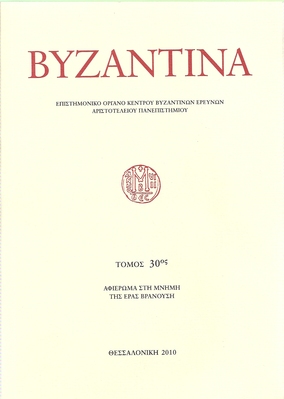Ένα μεσοβυζαντινό κιονόκρανο με έμβλημα στο Μεγάλο Μετέωρο
Part of : Βυζαντινά : επιστημονικόν όργανον Κέντρου Βυζαντινών Ερευνών Φιλοσοφικής Σχολής Αριστοτελείου Πανεπιστημίου ; Vol.30, No.1, 2010, pages 277-298
Issue:
Pages:
277-298
Parallel Title:
A middle byzantine emblem capital in Megalo Meteoro monastery
Author:
Abstract:
The article deals with a Byzantine capital used in the post Byzantine period as a stoup for holy water inside the Katholicon of Megaio Meteora Monastery. The capital, an artifact of high quality, reproduces in Byzantine terms a Corinthian variation of the roman period: the emblem capital. Emblem capitals, considered to originate in Asia Minor and be introduced in the Greek mainland on the Hadrian’s Arch, present the following decorative elements: acanthus leaves rising at the corners and a floral emblem, framed by helices and bordered by an ionian kymation at the lower part. Stylistic and iconographie comparisons of the emblems on the one hand (the “banana" shaped palmette and the vegetal scroll, all springing from a calyx) and of the corner palmette shaped acanthus leaves on the other, point towards a date of the capital in the reign of Basil I or of Leo VI the Wise. The corner leaves show an interesting Helladic form, influenced by some elements of Constantinopolitan origin appearing in the Monastery of Lips (907). The selection of the specific type and the sculptural elements are characterized by classicist and orientalistic tendencies, corresponding therefore to the new era which began for the theme of Hellas with the erection of Panagia in Skripou and Theologos in Thebes. The same data enable us to attribute the capital to the sculptural production of Southern Greece. Although the provenance of the capital is unknown, it is assumed that it came from the neighboring kastron of Stagoi. It is also suggested that Stagoi. for the first time mentioned in the Diatyposis of Leo VI the Wise (written between 901 and 907). were probably connected not only with the economic blossom witnessed in the theme of Hellas after Basil I, but also with the imperial decision to secure the passage from Macedonia to Thessaly. This decision may have been reached during the time of Leo VI the Wise who was at that time mainly concerned with the Arabs' and Bulgare’ hostility against the Empire.
Subject (LC):
Notes:
Περιέχει 13 εικόνες, Το άρθρο περιέχεται στο αφιέρωμα στη μνήμη της Έρας Βρανούση, Θα ήθελα να ευχαριστήσω τον πανοσιολογιότατο αρχιμανδρίτη κ. Αθανάσιο Αναστασίου. καθηγούμενο της Ιεράς Μονής του Μεγάλου Μετεώρου, καθώς και την κ. Κρυσταλία Μαντζανά. προϊστάμενη της 19ης Ε.Β.Α., οι οποίοι μου παραχώρησαν την άδεια μελέτης και δημοσίευσης. Ευχαριστώ επίσης την Τρικαλινή φίλη Διονυσία Νημά. που με συνόδεψε στις επισκέψεις μου στην Ι.Μ. Ιδιαίτερες ευχαριστίες οφείλω στον δάσκαλό μου. καθηγητή κ. Αριστοτέλη Μέντζο. και την Έφη Ντάφου για τις ωφέλιμες παρατηρήσεις· οποιαδήποτε λάθη ή αβλεψίες βαρύνουν αποκλειστικά εμένα.




